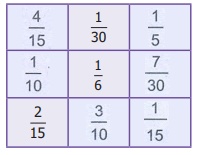Fractions | Term 3 Chapter 1 | 6th Maths - Addition and Subtraction of Unlike Fractions | 6th Maths : Term 3 Unit 1 : Fractions
Chapter: 6th Maths : Term 3 Unit 1 : Fractions
Addition and Subtraction of Unlike Fractions
Addition
and Subtraction of Unlike Fractions
Think about the situation
Venkat went to buy milk. He bought 1/2 litre first
and then he bought 1/4 litre. He wanted to find how much milk he bought altogether?
In order to find the total quantity of milk, he has to add 1/2 and 1/4. That is
1/2 + 1/4.
To add or subtract two unlike fractions, first we need to convert them into like
fractions.
Example 5
The teacher had given the same situation mentioned
above and asked two students Ravi and Arun
to solve it. They came out with the answers
for ½ + ¼.
Solution
Ravi’s way
Common Multiple
of 2 and 4 = 4.
Equivalent Fractions of
1/2 = (1 ×2) / (2 ×2) = 2/4
Now, add 1/2 + 1/4 = 2/4
+ 1/4
= (2 + 1) / (4 + 4) =
3/8
Therefore Venkat has bought 3/8 litres of milk.
Arun’s
way
Common Multiple
of 2 and 4 = 4.
Equivalent Fractions of
1/2 = (1
×2) / (2 ×2) = 2 /4
Now, add 1/2+ 1/4 = 2/4 +1/4
= (2 + 1) / 4 = 3/4
Therefore
Venkat has bought 3/4 litres of milk.
The teacher concludes that Arun’s way is correct.
This can be verified by the following diagram.

In the above illustration note that while adding
two like fractions the total number of parts (denominator) remains the same and
the two shaded parts (numerator) are added.
Example 6
Add 2/3 and 3/5 .
Solution
These are unlike fractions, aren’t they ? So first
we need to convert them into like fractions? Is it possible? Yes, always. How do
we do so? The common multiple of 3 and 5 is 15. Hence, we find the equivalent fractions
of 2/3 and 3/5 with denominator 15.

2/3 = (2 × 5) / (3 × 5) = 10 / 15
3/5 = (3 × 3) / (5 × 3) = 9 / 15
2/3 + 3/5 = 10/15 + 9/15 = 19 / 15
In the above example, the common denominator is
15 (3×5). Now we observe that the numerator and denominator of the first fraction
is multiplied by 5 which is the denominator of the second fraction. In the same
way, the second fraction is multiplied by 3 which is the denominator of the first
fraction. Now in finding the numerator of both the like fractions, we need to multiply
the numerator of the first fraction by 5 and the numerator of the second by 3. In
the denominator, 3×5 and 5×3 are of course the same. Thus, the technique of finding
the like fraction is called Cross Multiplication
technique.

Example 7
Simplify: 
Solution
By Cross
Multiplication technique, 
Think
about the situation
Vani has
3/4 litre of water in her bottle. She drank
1/2 litre of it. How much water is left in
the bottle? To find the amount of water remaining in her bottle, the amount of water
consumed by her must be subtracted from the amount of water she had initially. That
is 3/4 – 1/2
. This is solved in the following example.
Example 8
Simplify: 3/4 – 1/2
Solution
Common multiple of 2 and 4 is 4

Therefore, Vani has1/4 amount of water in the bottle. This can be verified by the following diagram.

Example 9
Find the difference between 3/4 and 2/7.
Solution
To find the
difference, first we should know, which is bigger between the two given fractions?
How do we find out?
We know that comparing 'like fractions' is easy,
but these are unlike fractions.
So, let us convert them into 'like fractions' and
compare. Again, we use common multiple 28 (4×7) to get equivalent fractions of 3/4
and 2/7 as 21/28 and 8/28. Here, 21/28 > 8/28 and hence 3/4 > 2/7.
Therfore, 3/4 − 2/7 = 21/28 − 8/28 = 13/28.
This can also be done by Cross Multiplication technique as

= [21 – 8] / 28 = 13/28 .
Try these
i) 2/3 + 5/7
[ (2 × 7) + (5 × 3) ] / [3 × 7]
[14 + 15] / 21 = 29/31
ii) 3/5 – 3/8
[24 – 15] / [5 × 8] = 9/40
Activity
Using the given fractions 1/5, 1/6,
1/10 , 1/15 , 2/15 , 4/15 , 1/30 , 7/30 and 9/30 fill in the missing ones in the
given 3×3 square in such a way that the addition of fractions through rows, columns
and diagonals give the same total 1/2 .

1/30 + 1/6 = [1 + 5]/30 = 6/30 = 1/5
1/2 – 6/30 = [15 – 6]/30 = 9/30 = 3/10
2/15 – 3/10 = [4 + 9]/30 = 13/30
1/2 – 13/30 = [15 – 13]/30 = 2/30 = 1/15
1/6 + 1/15 = [5 + 2]/30 = 7/30
1/2 – 7/30 = [15 – 7]/30 = 8/30 = 4/15
4/15 + 1/30 = [8 + 1]/30 = 9/30 = 3/10
1/2 – 9/30 = [15 – 9]/30 = 6/30 = 1/5
4/15 + 2/15 = 6/15 = 2/5
1/2 – 2/5 = [5 – 4]/10 = 1/10
1/2 – 4/15 = [15 – 8]/30 = 7/30

Related Topics